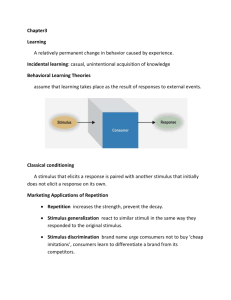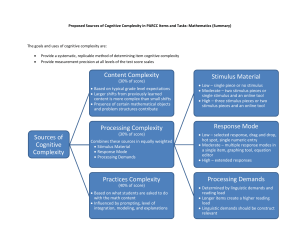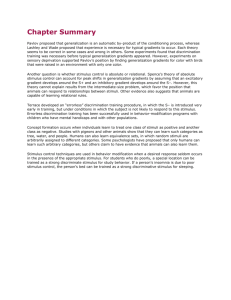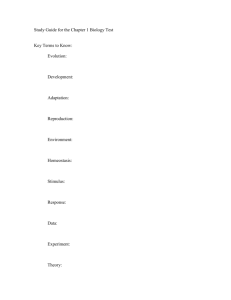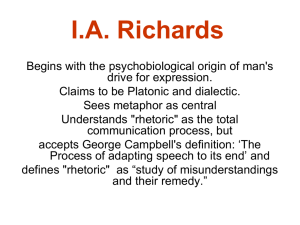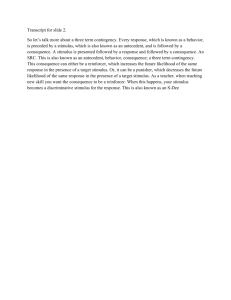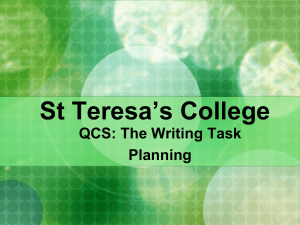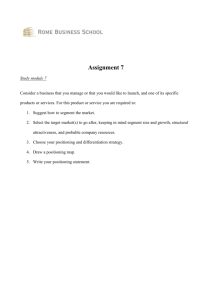MarketLink Concept Testing Template
advertisement
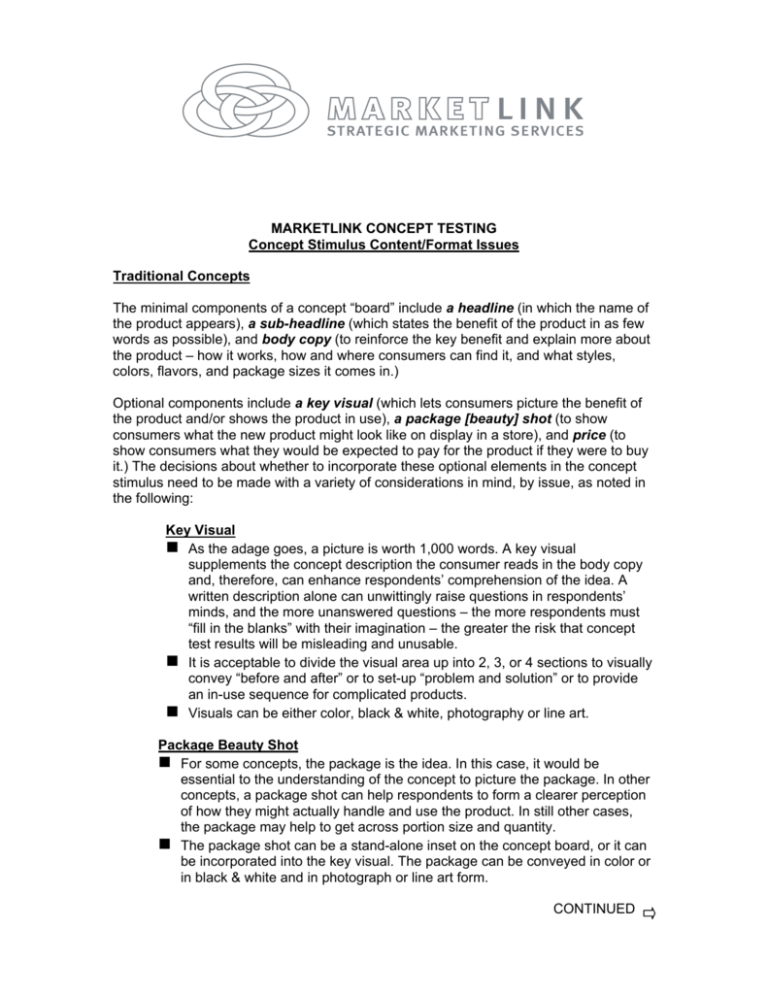
MARKETLINK CONCEPT TESTING Concept Stimulus Content/Format Issues Traditional Concepts The minimal components of a concept “board” include a headline (in which the name of the product appears), a sub-headline (which states the benefit of the product in as few words as possible), and body copy (to reinforce the key benefit and explain more about the product – how it works, how and where consumers can find it, and what styles, colors, flavors, and package sizes it comes in.) Optional components include a key visual (which lets consumers picture the benefit of the product and/or shows the product in use), a package [beauty] shot (to show consumers what the new product might look like on display in a store), and price (to show consumers what they would be expected to pay for the product if they were to buy it.) The decisions about whether to incorporate these optional elements in the concept stimulus need to be made with a variety of considerations in mind, by issue, as noted in the following: Key Visual As the adage goes, a picture is worth 1,000 words. A key visual supplements the concept description the consumer reads in the body copy and, therefore, can enhance respondents’ comprehension of the idea. A written description alone can unwittingly raise questions in respondents’ minds, and the more unanswered questions – the more respondents must “fill in the blanks” with their imagination – the greater the risk that concept test results will be misleading and unusable. It is acceptable to divide the visual area up into 2, 3, or 4 sections to visually convey “before and after” or to set-up “problem and solution” or to provide an in-use sequence for complicated products. Visuals can be either color, black & white, photography or line art. Package Beauty Shot For some concepts, the package is the idea. In this case, it would be essential to the understanding of the concept to picture the package. In other concepts, a package shot can help respondents to form a clearer perception of how they might actually handle and use the product. In still other cases, the package may help to get across portion size and quantity. The package shot can be a stand-alone inset on the concept board, or it can be incorporated into the key visual. The package can be conveyed in color or in black & white and in photograph or line art form. CONTINUED MarketLink Concept Testing Concept Stimulus Issues Continued Price Again, in some concepts, the price is a key element of the idea and needs to be shown. In other concepts – particularly where there are multiple sizes, flavors and styles that are priced differently – the price information becomes key to respondents’ full understanding of the idea. Perceived value is increasingly a driver in new product success or failure. Without a stated price on the concept, consumers may not form a clear perception of the value of the new product or service idea. Positioning Concept Stimuli These differ from product concept stimuli in the degree of concept development and understanding of the market potential for the product idea. A positioning concept is a product concept for which a specific, intended consumer target has been identified (or is being sought) and a single-minded reason-for-being – reasons for the target to buy this product r service – have been articulated. It is not uncommon for companies to have explored product concepts in focus groups to gain a better understanding of the potentially leverageable consumer benefits and then later develop one or more testable positionings for the new product idea. It is at this stage that early creative development begins on potential names and packaging concepts. By this stage, product prototypes are usually in development, and preliminary financial analyses reflect early cost, price and margin assumptions. Stimulus materials for a positioning concept will reflect this higher level of development in the following ways: The sub-headline will typically refer to the target consumer and state the product or brand positioning – again, in as few words as possible. The body copy will read more like an advertisement. Whereas a simple product concept body copy will describe the product r service, the positioning concept body copy tries to sell the product. It will use superlatives and articulate a number of facts (reasons why) in support the positioning offered in the sub-head. A key visual and package beauty shot are usually used in these stimuli and are often a higher quality of finish. For example, an appetite-appeal shot would frequently be photography rather than line art. A price is most certain to appear in the positioning stimulus as it is now a more crucial influence in consumers’ formation of opinions as to relevance and purchase interest. CONTINUED MarketLink Concept Testing Concept Stimulus Issues Continued Other Considerations A company’s decisions related to the content and format of testable concept stimulus should be made within a long-term perspective. That is, decisions concerning content and format of concept stimulus should take into account the company’s need to be able to compare and relate test scores of a growing reservoir of concepts over many years. This internal source of test normative data becomes a very valuable information asset for the marketer. The most important key to the development of this asset is consistency of execution of concept test stimulus over time. Less important than a marketer’s decisions on the inclusion or exclusion of certain concept stimulus components is the discipline to retain a chosen concept test format over the long haul. MEB/ 4/30/98 MARKETLINK CONCEPT TESTING Concept Stimulus Content/Format Template HEADLINE • Introducing (PRODUCT NAME) • New … from XYZ SUB-HEADLINE • State the benefit in as few words as possible KEY VISUAL • Picture the benefit • Show how product is used • May show package beauty shot • Depict “before/after” • Set up “problem/solution” BODY COPY • Reinforce the main benefit • Explain the product – how it works; how to use it; where to find it; etc. • Maximum of 100 - 150 words on entire page (fewer if possible) PRICE MEB/4/30/98
